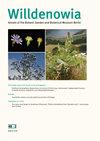在西班牙Almería的半沙漠中,新发现的撒哈拉-阿拉伯硬头裸子(石竹科)
IF 1.4
3区 生物学
Q2 PLANT SCIENCES
引用次数: 1
摘要
本文报道了在西班牙安达卢西亚阿尔梅利亚的塔伯纳斯半沙漠中发现的欧洲首个硬头裸鼠(Paronychia sclerocephala, sclerocephalus arabicus,石竹科)。在对该物种进行诊断性描述和生态解释后,我们提供了支持其在西班牙地区原生地位的论据,并探讨了解释该物种和其他一些生物地理上类似物种在当地发生的地理和历史原因。本文章由计算机程序翻译,如有差异,请以英文原文为准。
The Saharo-Arabian Gymnocarpos sclerocephalus (Caryophyllaceae) new to Europe in the semideserts of Almería, Spain
The first European record of Gymnocarpos sclerocephalus (Paronychia sclerocephala, Sclerocephalus arabicus, Caryophyllaceae), from the semidesert of Tabernas (Almeria, Andalusia, Spain), is presented. After a diagnostic description and ecological interpretation of the species, we provide arguments in favour of its native status in that Spanish region and explore the geographic and historical causes explaining the local occurrence of this and a number of other biogeographically analogous species.
求助全文
通过发布文献求助,成功后即可免费获取论文全文。
去求助
来源期刊

Willdenowia
PLANT SCIENCES-
CiteScore
4.60
自引率
5.30%
发文量
17
审稿时长
>12 weeks
期刊介绍:
Willdenowia is an international peer-reviewed journal publishing original research articles in English from the entire fields of plant, algal and fungal systematics, covering the evolution, taxonomy and nomenclature of these organisms as well as related fields such as floristics and plant geography. Articles on phylogeny and molecular systematics are especially welcome, as are review articles. Descriptions of new taxa may be considered, but only if supported by robust evidence. Narrowly regional studies of widespread taxa, routine typifications, checklists and new floristic records are generally not considered (excluding contributions to the Euro+Med-Checklist Notulae). Authors are encouraged to deposit duplicates of their material, especially nomenclatural types, in the Berlin herbarium (B).
 求助内容:
求助内容: 应助结果提醒方式:
应助结果提醒方式:


